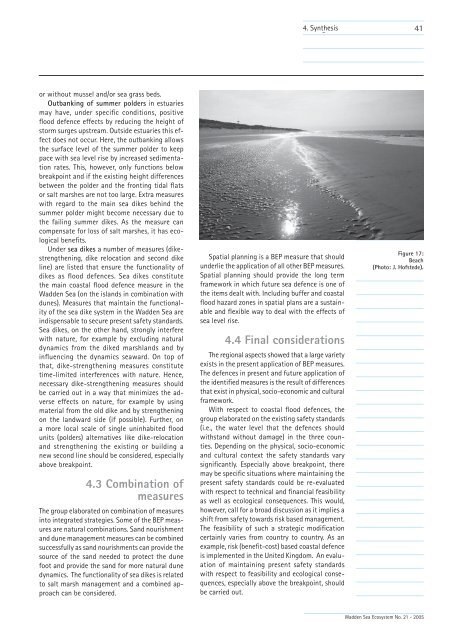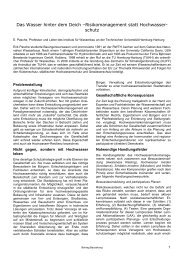Coastal Protection and Sea Level Rise - Hochwasser
Coastal Protection and Sea Level Rise - Hochwasser
Coastal Protection and Sea Level Rise - Hochwasser
You also want an ePaper? Increase the reach of your titles
YUMPU automatically turns print PDFs into web optimized ePapers that Google loves.
4. 3. Synthesis Integrated BEP Solutions<br />
41<br />
or without mussel <strong>and</strong>/or sea grass beds.<br />
Outbanking of summer polders in estuaries<br />
may have, under specifi c conditions, positive<br />
flood defence effects by reducing the height of<br />
storm surges upstream. Outside estuaries this effect<br />
does not occur. Here, the outbanking allows<br />
the surface level of the summer polder to keep<br />
pace with sea level rise by increased sedimentation<br />
rates. This, however, only functions below<br />
breakpoint <strong>and</strong> if the existing height differences<br />
between the polder <strong>and</strong> the fronting tidal flats<br />
or salt marshes are not too large. Extra measures<br />
with regard to the main sea dikes behind the<br />
summer polder might become necessary due to<br />
the failing summer dikes. As the measure can<br />
compensate for loss of salt marshes, it has ecological<br />
benefits.<br />
Under sea dikes a number of measures (dikestrengthening,<br />
dike relocation <strong>and</strong> second dike<br />
line) are listed that ensure the functionality of<br />
dikes as fl ood defences. <strong>Sea</strong> dikes constitute<br />
the main coastal flood defence measure in the<br />
Wadden <strong>Sea</strong> (on the isl<strong>and</strong>s in combination with<br />
dunes). Measures that maintain the functionality<br />
of the sea dike system in the Wadden <strong>Sea</strong> are<br />
indispensable to secure present safety st<strong>and</strong>ards.<br />
<strong>Sea</strong> dikes, on the other h<strong>and</strong>, strongly interfere<br />
with nature, for example by excluding natural<br />
dynamics from the diked marshl<strong>and</strong>s <strong>and</strong> by<br />
influencing the dynamics seaward. On top of<br />
that, dike-strengthening measures constitute<br />
time-limited interferences with nature. Hence,<br />
necessary dike-strengthening measures should<br />
be carried out in a way that minimizes the adverse<br />
effects on nature, for example by using<br />
material from the old dike <strong>and</strong> by strengthening<br />
on the l<strong>and</strong>ward side (if possible). Further, on<br />
a more local scale of single uninhabited flood<br />
units (polders) alternatives like dike-relocation<br />
<strong>and</strong> strengthening the existing or building a<br />
new second line should be considered, especially<br />
above breakpoint.<br />
4.3 Combination of<br />
measures<br />
The group elaborated on combination of measures<br />
into integrated strategies. Some of the BEP measures<br />
are natural combinations. S<strong>and</strong> nourishment<br />
<strong>and</strong> dune management measures can be combined<br />
successfully as s<strong>and</strong> nourishments can provide the<br />
source of the s<strong>and</strong> needed to protect the dune<br />
foot <strong>and</strong> provide the s<strong>and</strong> for more natural dune<br />
dynamics. The functionality of sea dikes is related<br />
to salt marsh management <strong>and</strong> a combined approach<br />
can be considered.<br />
Spatial planning is a BEP measure that should<br />
underlie the application of all other BEP measures.<br />
Spatial planning should provide the long term<br />
framework in which future sea defence is one of<br />
the items dealt with. Including buffer <strong>and</strong> coastal<br />
flood hazard zones in spatial plans are a sustainable<br />
<strong>and</strong> flexible way to deal with the effects of<br />
sea level rise.<br />
4.4 Final considerations<br />
The regional aspects showed that a large variety<br />
exists in the present application of BEP measures.<br />
The defences in present <strong>and</strong> future application of<br />
the identified measures is the result of differences<br />
that exist in physical, socio-economic <strong>and</strong> cultural<br />
framework.<br />
With respect to coastal flood defences, the<br />
group elaborated on the existing safety st<strong>and</strong>ards<br />
(i.e., the water level that the defences should<br />
withst<strong>and</strong> without damage) in the three counties.<br />
Depending on the physical, socio-economic<br />
<strong>and</strong> cultural context the safety st<strong>and</strong>ards vary<br />
significantly. Especially above breakpoint, there<br />
may be specific situations where maintaining the<br />
present safety st<strong>and</strong>ards could be re-evaluated<br />
with respect to technical <strong>and</strong> financial feasibility<br />
as well as ecological consequences. This would,<br />
however, call for a broad discussion as it implies a<br />
shift from safety towards risk based management.<br />
The feasibility of such a strategic modification<br />
certainly varies from country to country. As an<br />
example, risk (benefit-cost) based coastal defence<br />
is implemented in the United Kingdom. An evaluation<br />
of maintaining present safety st<strong>and</strong>ards<br />
with respect to feasibility <strong>and</strong> ecological consequences,<br />
especially above the breakpoint, should<br />
be carried out.<br />
Figure 17:<br />
Beach<br />
(Photo: J. Hofstede).<br />
Wadden <strong>Sea</strong> Ecosystem No. 21 - 2005




